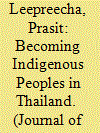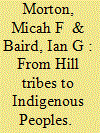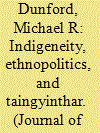|
|
|
Sort Order |
|
|
|
Items / Page
|
|
|
|
|
|
|
| Srl | Item |
| 1 |
ID:
165105


|
|
|
|
|
| Summary/Abstract |
This article investigates the processes of becoming Indigenous Peoples in Thailand by tracing the transnational relationships and influences of global Indigenous movements on the creation of the Network and the Council of Indigenous Peoples in Thailand (NIPT and CIPT). In addition, it examines the Indigenous Peoples’ movement toward both internal and external recognition. I argue that in Thailand the Indigenous Peoples movement stems from the global movement and exists in relation to international organisations. Within Thailand, the movement represents a deterritorialisation of the ethnoscape, with those now identified as Indigenous Peoples previously being identified as ‘tribal peoples’, ‘ethnic minorities’, or ‘Others’ who threatened national security. Indigenous Peoples are also self-identifying as native and marginalised peoples whose basic rights must be recognised and who advocate for equal treatment as citizens. Yet, the Indigenous Peoples’ movement in Thailand is developing through a process of ongoing negotiations with various internal and external sectors. As a Hmong anthropologist and long-time participant in the Indigenous movement in Thailand, in addition to secondary sources, I draw mainly on personal observations and interviews with key informants.
|
|
|
|
|
|
|
|
|
|
|
|
|
|
|
|
| 2 |
ID:
165104


|
|
|
|
|
| Summary/Abstract |
This article presents a chronology of the growth of the concept of Indigeneity in Thailand, analysing the particular ways in which the global Indigenous movement has taken root in the country. In Thailand, transnational support networks and the opening of political associational space played key roles in facilitating the growth of, first, a regional, and later a national Indigenous movement during the 1980s and early 2000s, respectively. Indigenous Peoples in Thailand are asserting their identity by drawing on a new concept of Indigeneity being promoted by the United Nations and other international advocacy organisations that identifies them not only as first peoples, but crucially as colonised or oppressed peoples. Indigenous Peoples in Thailand are further asserting both their cultural distinctiveness and their compatibility with the Thai nation. The Indigenous movement in Thailand differs from movements in Australia, Canada, and the United States where Indigenous Peoples must perform their cultural distinctiveness to maintain political recognition, and in turn are accused of being not different enough when exercising their rights. In Thailand, rather, Indigenous Peoples are accused of being not Thai enough in their efforts to push for any political recognition. While the Thai government denies the relevance of the concept of Indigeneity to Thailand, it is clear that the Indigenous movement in Thailand has grown since the early 2000s. In fact, state policies between the 1950s and early 2000s contributed toward the scaling-up of a pan-Hill tribe identity among the core groups associated with the movement.
|
|
|
|
|
|
|
|
|
|
|
|
|
|
|
|
| 3 |
ID:
165106


|
|
|
|
|
| Summary/Abstract |
In Myanmar, the idea of ‘indigeneity’ has been mobilised in two radically different ways. Ethnonationalist groups such as the Chin National Front and the Karen National Union have utilised the concept to lobby for increased autonomy in international forums such as the United Nations, while the Burmese state has used the idea of indigeneity (or native-ness, typically translated as taingyinthar in Burmese) to exclude certain minorities — most prominently the Rohingya — by explicitly striking them from the official list of Myanmar's ‘national races’. To clarify how this definitional tension has developed, this article will situate the competing Burmese appeals to indigeneity within the history of international indigeneity politics, and compare the Burmese ‘Indigenous situation’ to other Asian countries that have addressed the question of who counts and does not count as Indigenous.
|
|
|
|
|
|
|
|
|
|
|
|
|
|
|
|
| 4 |
ID:
165103


|
|
|
|
|
| Summary/Abstract |
Only a few decades ago, there was not a country in Asia that recognised the existence of specifically and legally defined ‘Indigenous Peoples’. In recent years, however, that has changed, albeit unevenly. The concept of indigeneity is being increasingly accepted, both by governments and the public, although it remains highly controversial, even in countries where it has made some ground legally. For example, in the region we now frequently refer to as ‘Southeast Asia’, the governments of the Philippines and Cambodia now define particular ethnic groups of people as Indigenous, and are providing these groups with particular rights. In other countries in the region, the concept of Indigenous Peoples is still not legally recognised, but there is increasing acceptance of the concept, or at least recognition of it amongst certain groups. Questions related to the proliferation and contested nature of the concept of Indigenous Peoples were addressed during a multidisciplinary workshop organised by the Center for Southeast Asian Studies at the University of Wisconsin-Madison in March 2015. This special issue of the Journal of Southeast Asian Studies is devoted to considering some of the conceptions of indigeneity in Southeast Asia that brought together a group of scholars and activists from various countries in Asia and the United States for the workshop, which was financially supported through a grant provided by Open Society Foundations.
|
|
|
|
|
|
|
|
|
|
|
|
|
|
|
|
| 5 |
ID:
165107


|
|
|
|
|
| Summary/Abstract |
Indigeneity, a concept and construct, is increasingly gaining currency in academia, in the political sphere, and in public debates. Indigeneity as an active political force with international support has become a resource in identity politics. This article focuses on the dynamics of how the transnational idea of indigeneity has been nationally installed and locally translated within the context of the ethnohistory of an Indigenous movement that stemmed from local–societal relations with the state. The idea of indigeneity is seen as both local and global because it is globally circulated but locally articulated as well as globally charged but locally framed. Focusing on the Chittagong Hill Tracts, in the borderlands of South and Southeast Asia and home to 11 Indigenous groups in Bangladesh, the article argues that the local translation of global indigeneity is necessary for ensuring the rights and entitlements of Indigenous Peoples.
|
|
|
|
|
|
|
|
|
|
|
|
|
|
|
|
| 6 |
ID:
165110


|
|
|
|
|
| Summary/Abstract |
This article, which looks at Indigenous communities in the multiethnic, multicultural region of Sabah, East Malaysia, on the island of Borneo, argues that indigeneity is not primordial, but exists in relation to dominant identities as well as other non-dominant, Indigenous groups. Moreover, Indigenous Peoples are not passive recipients of colonial or even postcolonial Othering: their identity is contextualised and contested within majority–minority relations. The article begins with a brief history of the dominant Kadazandusun nationalism in Sabah, in the context of the overarching Bumiputra policy of Malaysia, which privileges constructed Malayness, as background to the discourses and practices of smaller groups of land-based Murut and the sea-oriented ‘Bajau’, where identity switching is taking place in tandem with environmental justice claims. The land-based communities (Murut) have found leverage in making identity and livelihood claims attached to place (here, state-declared forest reserves that seek to exclude them) in line with the recent global environmental justice focus on participatory conservation rather than the older ‘fortress conservation’ model still dominant in state conservation thinking. However, the sea-oriented peoples (Bajau) require other social symbols than land for making their identity claims, in this instance, via claims to ‘modern’ livelihoods and as managers of marine resources with reference to the newly established Tun Mustapha Park. In Sabah, participatory conservation is being reappropriated by Indigenous Peoples to assert claims about place and /or livelihoods; if bureaucratised, however, this form of conservation might turn out to be less than participatory.
|
|
|
|
|
|
|
|
|
|
|
|
|
|
|
|
| 7 |
ID:
165108


|
|
|
|
|
| Summary/Abstract |
What are the practical and cultural consequences of embracing the ‘Indigenous’ label? Despite universalising aspirations, the concept of indigeneity carries distinct political connotations in the Philippines, where the Indigenous Peoples’ Rights Act has created a bureaucracy that purportedly responds to the special needs of Indigenous Peoples, including the preservation of cultural traditions and securing title to ancestral lands. While laudatory on the surface, in practice the current legal and bureaucratic framework allows the state to impose its own definition of indigeneity, often compelling indigenous minorities to conform to stereotypes in order to acquire the fundamental rights and benefits that, by law, are supposed to be guaranteed. The Philippine states’ requirements for being recognised as ‘Indigenous’ are transforming how Indigenous Peoples maintain and perform their ancestral traditions, often leading to highly divisive internal debates about proper cultural and political representation. This article examines the case of Higaunon Lumads in northern Mindanao, who have been responding locally to over thirty years of national trends in participatory development that require increased engagement with government bureaucracy. I explore how ‘indigeneity’ has been defined and employed by Higaunons in the service of ‘preserving tradition’, the political and other consequences that have emerged in this context, and the perils of representing and commodifying indigeneity in modern Southeast Asia.
|
|
|
|
|
|
|
|
|
|
|
|
|
|
|
|
| 8 |
ID:
165109


|
|
|
|
|
| Summary/Abstract |
After the fall of the Marcos regime in 1986, Philippine policymakers became the first in Asia to recognise indigeneity and Indigenous rights. By law, Indigenous groups throughout the archipelago now have priority rights to their ‘ancestral domains’, but in return they are expected to maintain an ‘ecological balance’ and cooperate with environmental regulations. As in many other parts of the world, the conditionalities of recognition mean that invocations of Indigenous rights often serve to initiate ever-deeper entanglements with governmental power. At the same time, however, Indigenous Peoples and their advocates do not approach the dilemmas of recognition as hapless bystanders; rather, they negotiate them in strategic and often unexpected ways. This article considers how members of Indigenous Palawan communities in the southwestern Philippines have used dominant policy assumptions to intervene in dispossessory processes. Specifically, I examine instances in which they have: (1) codified a ‘tradition’ of inheritance to influence legislative outcomes; (2) performed the policy narrative of ‘ecological balance’ to shape the outcome of conservation interventions; and (3) filed a civil case tacitly challenging official expectations that they govern themselves as homogenous collectivities. These examples, I argue, offer broader insights into the paradoxical and at times unexpected consequences of legislating Indigenous rights.
|
|
|
|
|
|
|
|
|
|
|
|
|
|
|
|
|
|
|
|
|